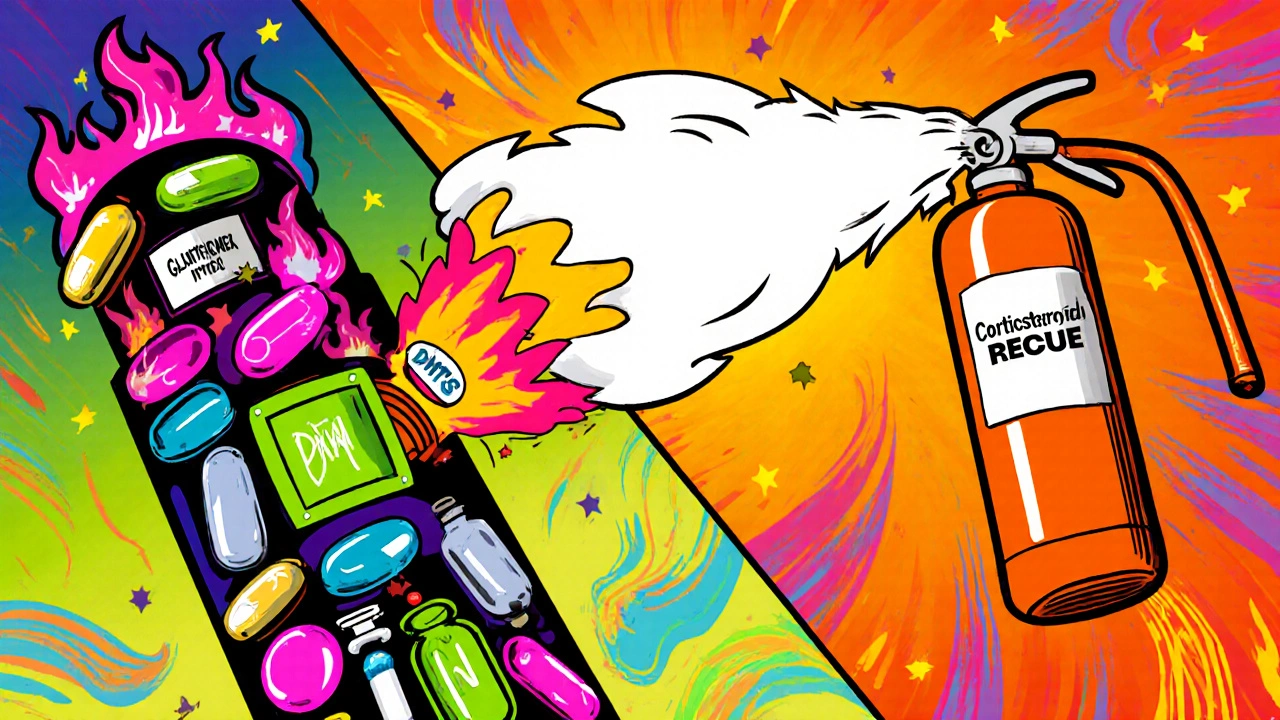19 Oct 2025
- 9 Comments
DMT Selection Guide
This tool helps you understand which disease-modifying therapies (DMTs) might be suitable based on your disease characteristics and lifestyle factors. Always consult your neurologist before making treatment decisions.
Your results will appear here after selecting options.
When a condition flickers between flare‑ups and calm periods, the word “relapsing‑remitting” often pops up. You’ve probably heard it in the context of multiple sclerosis, but the pattern shows up in other autoimmune disorders too. Knowing how medication fits into the picture can turn those unpredictable swings into a more manageable rhythm.
Quick Takeaways
- Relapsing‑remitting diseases (RRDs) are characterized by episodic attacks followed by partial or full recovery.
- Disease‑modifying therapies (DMTs) aim to reduce relapse frequency and slow disability progression.
- Corticosteroids are the go‑to rescue for acute flares, while DMTs work long‑term.
- Choosing the right drug depends on disease severity, MRI activity, patient lifestyle, and safety profile.
- Regular monitoring-MRI scans, blood tests, and adherence checks-keeps treatment on track.
What Is a Relapsing‑Remitting Disease?
Relapsing‑Remitting Disease is a pattern of illness where patients experience distinct episodes of new or worsening symptoms (relapses) followed by periods of partial or complete remission. During remission, the immune system often still harbors low‑grade inflammation, which can silently damage tissue. The classic example is Multiple Sclerosis, a nervous‑system disorder affecting roughly 2.8 million people worldwide. Other RRDs include certain forms of lupus and inflammatory bowel disease, but the therapeutic principles overlap.
Why Medication Is Central to Control
Without treatment, each relapse can chip away at your nervous system or organ function, leading to irreversible disability. Medications serve two core purposes:
- Preventive (Disease‑Modifying) Therapy: Lowers the odds of a new attack and slows long‑term deterioration.
- Rescue (Symptomatic) Therapy: Quickly dampens inflammation during an active relapse to speed recovery.
Think of preventive drugs as a fire alarm system-always on, reducing the chance of a blaze. Rescue meds are the fire extinguisher you grab when a flare does happen.
Preventive Arsenal: Disease‑Modifying Therapies (DMTs)
DMTs target the immune mechanisms that drive relapses. They differ in route, frequency, and safety profile. Below is a snapshot of the most widely used options.
| Drug | Class | Administration | Typical Frequency | Main Benefit | Common Side‑Effect |
|---|---|---|---|---|---|
| Beta interferon (e.g., Avonex, Rebif) | Immunomodulator | Injection | Weekly or three times weekly | Reduces relapse rate by ~30% | Flu‑like symptoms, injection site reactions |
| Glatiramer acetate (Copaxone) | Immunomodulator | Injection | Daily or three times weekly | Effective in early disease | Injection site pain, transient rash |
| Oral DMTs (e.g., dimethyl fumarate, fingolimod) | Various (anti‑inflammatory, S1P modulator) | Oral capsule | Once daily (dimethyl fumarate) or daily/weekly (fingolimod) | Convenient; good for patients averse to injections | Gastrointestinal upset, lymphopenia |
| Monoclonal antibodies (e.g., natalizumab, ocrelizumab) | Targeted immune‑cell inhibition | IV infusion | Every 4 weeks (natalizumab) or every 6 months (ocrelizumab) | High efficacy; can cut relapse rate by >50% | Infusion reactions, increased infection risk |
Choosing among these hinges on how active your disease is, your lifestyle, and how you weigh benefits versus risks. For example, a young professional who travels often may favor oral DMTs for convenience, while someone with aggressive MRI activity might need a high‑efficacy monoclonal antibody.

Rescue Medication: Corticosteroids
When a relapse strikes, high‑dose corticosteroids (usually methylprednisolone) are prescribed for 3‑5 days. They rapidly curb inflammation, shortening recovery time by a few weeks on average. The downside? Short‑term side‑effects like insomnia, mood swings, and blood‑sugar spikes. Long‑term use is avoided because of bone‑loss and cataract risk.
How Doctors Pick the Right Regimen
Selection isn’t a one‑size‑fits‑all decision. Neurologists consider several factors:
- Disease severity: Number of relapses in the past year, disability scores, and MRI lesion load.
- Patient preferences: Injection aversion, travel schedule, desire for oral versus infusion therapy.
- Safety profile: Existing comorbidities such as liver disease or a history of infections.
- Cost and access: Insurance coverage and regional availability.
Usually, the process starts with a first‑line injectable (beta interferon or glatiramer), escalating to oral or infused therapies if disease activity persists.
Monitoring: Keeping the Treatment on Track
Medication alone isn’t enough-you need regular check‑ins:
- MRI scans every 6‑12 months assess new lesions or silent disease activity.
- Blood work monitors liver enzymes, lymphocyte counts, and antibody formation for biologics.
- Patient‑reported outcomes (fatigue levels, walking speed) help gauge real‑world impact.
- Adherence tracking - missed doses can erode the protective effect. Digital apps or pill‑boxes are handy tools.
Early detection of subclinical activity often prompts a therapy switch before the next clinical relapse.

Common Pitfalls and How to Avoid Them
Even the best regimen can stumble if you overlook practical details:
- Forgetfulness: Set alarms or use an app that sends daily reminders.
- Side‑effect mismanagement: Report flu‑like symptoms early; a simple dose‑adjustment can make a big difference.
- Ignoring labs: Skipping quarterly blood tests can hide rising liver enzymes or low white‑cell counts.
- Staying on a failing drug: If you’ve had two relapses in a year despite adherence, talk to your neurologist about escalation.
Future Directions: Personalized Medicine & Clinical Trials
Researchers are moving beyond the “one drug fits all” model. Genetic markers and advanced imaging are being explored to predict who will respond best to a specific DMT. Ongoing clinical trials in 2025 are testing next‑generation oral agents that target the JAK‑STAT pathway, aiming for similar efficacy to monoclonal antibodies but with oral convenience.
Participating in a trial can grant early access to cutting‑edge therapies, but weigh the commitment-extra visits, possible placebos, and strict monitoring.
Bottom Line: A Balanced Approach Wins
Medication is the backbone of managing a relapsing‑remitting disease, but success hinges on tailoring therapy to your unique disease pattern, lifestyle, and risk tolerance. Pair the right drug with vigilant monitoring, and you’ll turn unpredictable flare‑ups into a manageable part of life.
What is the difference between disease‑modifying therapies and corticosteroids?
Disease‑modifying therapies work long‑term to lower the chance of future relapses and slow disability, while corticosteroids are short‑term, high‑dose drugs used to quickly calm an active flare.
How often should MRI scans be performed?
Most neurologists recommend an MRI every 6‑12 months, especially after a change in therapy or if there’s suspicion of new disease activity.
Can I switch from an injectable DMT to an oral one?
Yes. If injections are inconvenient or you’ve had breakthrough relapses, your doctor can transition you to an oral DMT after a short wash‑out period to avoid overlap.
What are the main safety concerns with monoclonal antibodies?
The biggest worries are infusion reactions and a higher risk of infections, especially progressive multifocal leukoencephalopathy (PML). Regular blood monitoring and MRI checks help manage these risks.
How can I improve my medication adherence?
Use digital reminder apps, set a consistent daily routine (like taking medication with breakfast), keep a pill‑box, and discuss any side‑effects with your doctor promptly so adjustments can be made.


Felix Chan
October 19, 2025Great rundown!
I love how you broke down the difference between DMTs and steroids-it really helps demystify the treatment plan.
For anyone juggling work and appointments, the reminder about digital apps is gold.
Staying on top of those blood tests can feel like a hassle, but catching issues early makes the whole journey smoother.
Keep the practical tips coming!
DHARMENDER BHATHAVAR
October 26, 2025The distinction between preventive DMTs and rescue steroids is clinically pivotal.
Adherence monitoring should be protocolized across all care settings.
Madhav Dasari
November 2, 2025Listen up, folks-if you think a pill alone will save you, think again!
The real hero is the partnership between you, your neurologist, and the monitoring schedule.
Imagine your MRI as a weather radar, spotting storms before they hit.
Pair that with a reliable reminder app, and you’re practically steering the ship yourself.
Even the toughest meds become manageable when you slot them into your daily routine.
So grab that calendar and own your treatment!
Thokchom Imosana
November 9, 2025What the original post glosses over is the hidden lattice of corporate interests that silently dictate which DMTs are advertised as "convenient".
The notion that a simple reminder app can "steer the ship" ignores the fact that many of these applications are funded by pharmaceutical giants seeking to embed brand loyalty.
Every time a patient logs a dose, metadata is harvested and fed back to insurers, creating a feedback loop that pressures clinicians to prescribe newer, more expensive molecules.
Moreover, the so‑called "weather radar" of MRI scans is itself a double‑edged sword, as frequent imaging drives up healthcare costs and fuels the cycle of overtreatment.
The clinical trials that birthed the high‑efficacy monoclonal antibodies were largely financed by the same conglomerates that now market them directly to patients via glossy brochures.
One must ask why oral agents are praised for convenience while infusion centers receive subsidies, a discrepancy that only makes sense when one examines the hidden subsidy pipelines.
The safety profiles presented in peer‑reviewed journals are often sanitized, with long‑term adverse events relegated to supplementary tables few clinicians bother to read.
Patients are thus left to trust an industry that benefits more from chronic medication adherence than from genuine health outcomes.
Even the recommendation to switch from injectables to oral agents after a wash‑out period is predicated on the assumption that the patient will remain compliant, a premise that is rarely tested in real‑world settings.
The ‘balanced approach’ championed by the author masks an underlying agenda to keep the market saturated with a diversified portfolio of drugs.
While the author emphasizes personalized medicine, the reality is that most insurance formularies still force a one‑size‑fits‑all selection based on negotiated rebates.
Thus the patient’s autonomy is subtly eroded, replaced by algorithmic recommendations baked into electronic health records.
If you truly wish to empower yourself, consider seeking out independent clinical trials that are not tied to the major pharmaceutical behemoths.
Such trials often provide genuine innovation without the profit‑driven strings attached, though they demand a higher personal commitment.
In the end, the onus is on the informed individual to dissect the marketing veneer and demand transparency from both doctors and insurers.
Only then can the promise of a "manageable rhythm" be realized without surrendering to hidden corporate conduct.
Jay Kay
November 16, 2025Honestly, most of the hype around new DMTs is overblown.
The side‑effects often outweigh the modest relapse reduction.
If you’re not careful, you’ll trade one problem for another.
Stick to tried‑and‑true therapies unless you have a compelling reason to switch.
Kevin Sheehan
November 23, 2025The ethical calculus isn’t as black and white as you paint it.
While novelty can be alluring, dismissing advances outright neglects the very essence of medical progress.
One must balance humility with curiosity, lest stagnation become the true danger.
Consider the patients who have benefitted from those so‑called "overblown" agents.
A nuanced perspective serves everyone better.
Jameson The Owl
November 30, 2025Patients often sleep through the subtle warnings offered by routine lab work.
The physician writes the order and the patient forgets.
The disease continues its silent march beneath the surface.
A single missed blood test can lead to liver toxicity that could have been avoided.
The system assumes compliance without verification.
Technology could fill the gap but it is rarely adopted.
Insurance policies favor office visits over home monitoring.
Consequently the burden returns to the individual.
Without a reliable reminder even the best drug fails.
The irony is that we invest in expensive medicines while neglecting cheap adherence tools.
A cultural shift is needed to prioritize simple checks.
Only then will outcomes improve.
Rakhi Kasana
December 7, 2025While I appreciate the thorough overview, I’d caution against assuming every patient can manage complex schedules.
Some individuals simply lack the resources for frequent MRI scans or infusion appointments.
Tailoring therapy should also factor in socioeconomic realities, not just disease activity.
A realistic plan respects both medical and personal constraints.
Sarah Unrath
December 14, 2025i think u should also check the insurance before start any new med its a big deal
folks forget that a simple co-pay can break the whole plan